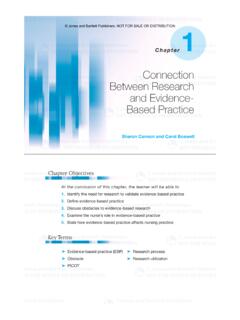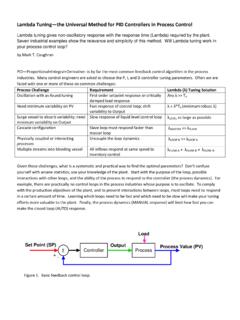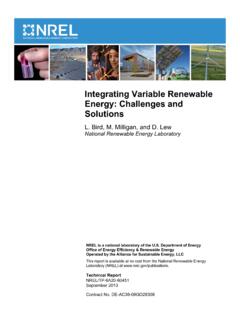Transcription of Nursing education: past, present, Future
1 Jones and Bartlett Publishers, LLC. NOT FOR SALE OR DISTRIBUTION. 2. c h a p t e r Nursing education : Past, Present, Future Martha Scheckel PhD, RN. Learning Outcomes After reading this chapter you will be able to: Develop an understanding of the historical evolutions, contributions, and differences of various Nursing education programs. Critique contemporary options for Nursing education in the context of social, political, and economic trends and issues. Explain the process of accreditation in Nursing education . Analyze curriculum and instruction in relation to learning Nursing practice. Develop a personal philosophy of Nursing education that reflects trends and issues in Nursing education and practice. Introduction This chapter provides a descriptive account of Nursing education including how its past has shaped its present and how current times are influencing and delineating its Future .
2 Understanding the continuum of development in Nursing education promotes an awareness of the diversity that exists within Nursing education and the common purposes that bind it together, encourages shared understandings of the various pathways that exist within Nursing education , and promotes community among Nursing students, 27. 27 9/21/08 12:25:28 PM. Jones and Bartlett Publishers, LLC. NOT FOR SALE OR DISTRIBUTION. 28 chapter 2: Nursing education : Past, Present, Future nurse educators, and nurses regarding the complexities surrounding educational preparation for Nursing practice. This chapter begins with a discussion of the levels of Nursing education preva- lent since the turn of the 20th century and the issues associated with each pro- gram (see Table 2-1).
3 The discussion begins with practical Nursing , the most basic level of Nursing education , and progresses to describing more advanced Nursing education programs. The second half of the chapter focuses on curriculum and instruction in Nursing education , beginning with a description of curriculum and instruction and including exemplars that describe what students learn and how they learn it in today's Nursing schools. One might wonder why it is impor- tant for Nursing students to understand curriculum and instruction. In the past, what and how students learned was the specialty of faculty. However, recent evi- dence suggests that student-centered curriculum and instruction can improve learning outcomes (Candela, Dalley, & Benzel-Lindley, 2006).
4 As faculty respond to this trend, they seek approaches that overcome learning environments where teaching and learning as well as the teacher and the learner are separate, discrete, polarizing entities, each with his or her own predetermined roles, functions, and expected responsibilities. This means that students play an increasingly active role in their own learning. Therefore, a goal of the latter part of this chapter is to pro- mote dialogue between teachers and students to encourage mutual trust, respect, and understanding for the content and processes involved in the preparation of Nursing students for contemporary Nursing practice. Table The Historical Evolution of Nursing education Programs Early 1900s 1920s 1930s 1940s 1950s 1960s present Practical Nursing Practical Nursing Practical Nursing Practical Nursing Nightingale Schools Diploma schools Diploma schools Diploma schools Diploma schools BSN BSN BSN.
5 ADN ADN. Postgraduate education Postgraduate Master's degree Master's degree and education CNL. EdD for nurses Doctorates for nurses PhD, DNSc, ND, DNP. Abbreviations key for Table 2-1: ADN associate degree in Nursing ; BSN bachelor's of science in Nursing ; CNL . clinical nurse leader; DNP doctorate of Nursing practice; DNSc doctorate of Nursing science; EdD doctorate of education ; ND Nursing doctorate; PhD doctorate of philosophy 28 9/21/08 12:25:29 PM. Jones and Bartlett Publishers, LLC. NOT FOR SALE OR DISTRIBUTION. Understanding Nursing education Programs 29. As with any chapter in a Nursing textbook, it is important to remember that this chapter provides an extensive synopsis of Nursing education , particularly important aspects of the topics at hand.
6 Students and teachers are encouraged to use this chapter as a platform for discussion, which can be further enriched by exploring the reference list provided at the end of the chapter. In this way, this chapter provides an excellent gateway to engage readers in the study of Nursing education and to pursue ways of integrating its content with other sources of knowledge. Understanding Nursing education Programs To gain an understanding of the various Nursing education programs and the con- text within which they were developed, the discussion for each program includes a historical account of the program's development, the unique and significant issues and challenges associated with the program, and information on contem- porary trends related to the program.
7 This approach provides a comprehensive overview that captures the essence of available avenues to achieving a Nursing degree. A description of mobility programs and a discussion of the educational accreditation process and its important role in ensuring high quality Nursing edu- cation programs are also included. Practical Nursing education Unlike the historically untrained or poorly trained practical nurse, who had unlim- ited and unsupervised freedom to practice, the present practical nurse is often a hybrid. Today's practical/vocational Nursing student is being taught basic skills during the educational program. After licensing, the LPN/LVN [practical nurse] is permitted to perform complex Nursing , as delegated by the registered nurse and allowed by the nurse practice act (Hill & Howlett, 2005, p.)
8 80). Responding to a Need: A Historical Overview of Practical Nursing education Practical Nursing , the most basic level of Nursing practice, began with the industrial revolution of the late 1800s. To meet labor workforce demands during this time, many people moved from rural areas to urban areas. Women needing employ- ment often provided domestic services, including those associated with caring for the sick (Kurzen, 2005). To support the skills of this new healthcare provider, in 1892 the Young Women's Christian Association (YWCA) located in Brooklyn, New York, offered the first formal practical Nursing course. Over time, landmark reports about the state of Nursing education contributed to the development of practical Nursing programs.
9 For example, in 1923 Josephine Goldmark compiled a report (see Table 2-2) titled Nursing and Nursing education in the United States. In it she recommended higher education standards for practical nurses, laws 29 9/21/08 12:25:29 PM. Jones and Bartlett Publishers, LLC. NOT FOR SALE OR DISTRIBUTION. 30 chapter 2: Nursing education : Past, Present, Future Table Documents Influencing Trends and Issues in Nursing education Name of Year Contribution to Document Published Nursing education Goldmark 1923 Studied the field of Nursing education and Report recommended minimal education standards Burgess Report 1928 Studied Nursing practice and education and addressed the need for major changes in the profession and for the development of a more comprehensive educational philosophy Brown Report 1948 Recommended vocational education for practical nurses and recommended that education for registered nurses be in an institution of higher learning Ginzberg Report 1949 Suggested it would be more economical for hospitals to eliminate diploma Nursing programs and begin
10 A 2-year course of study for student nurses in colleges Nursing Schools 1950 Identified that many schools of Nursing at Mid-Century were not meeting standards, which provided (West & evidence for reforming diploma Nursing Hawkins) education regulating their practice, and improved environments for their training. In 1948. Lucille Brown compiled another report, Nursing for the Future , which hastened the growth of practical Nursing programs by emphasizing vocational schools as good environments for practical Nursing programs. Today most practical Nursing pro- grams are in vocational schools. Working as a Practical Nurse: Scope and Function Since the first half of the 20th century, the scope and function of practical nurses have become increasingly sophisticated.











